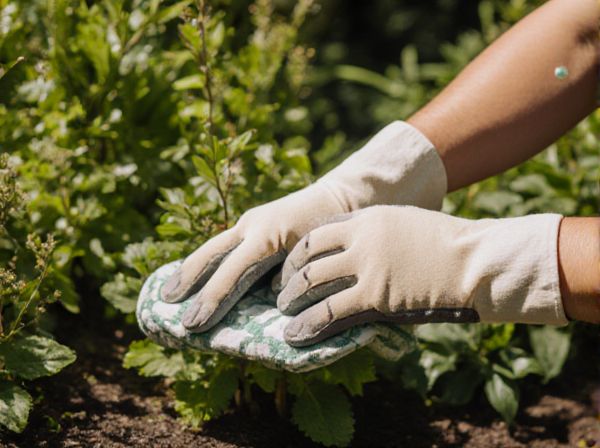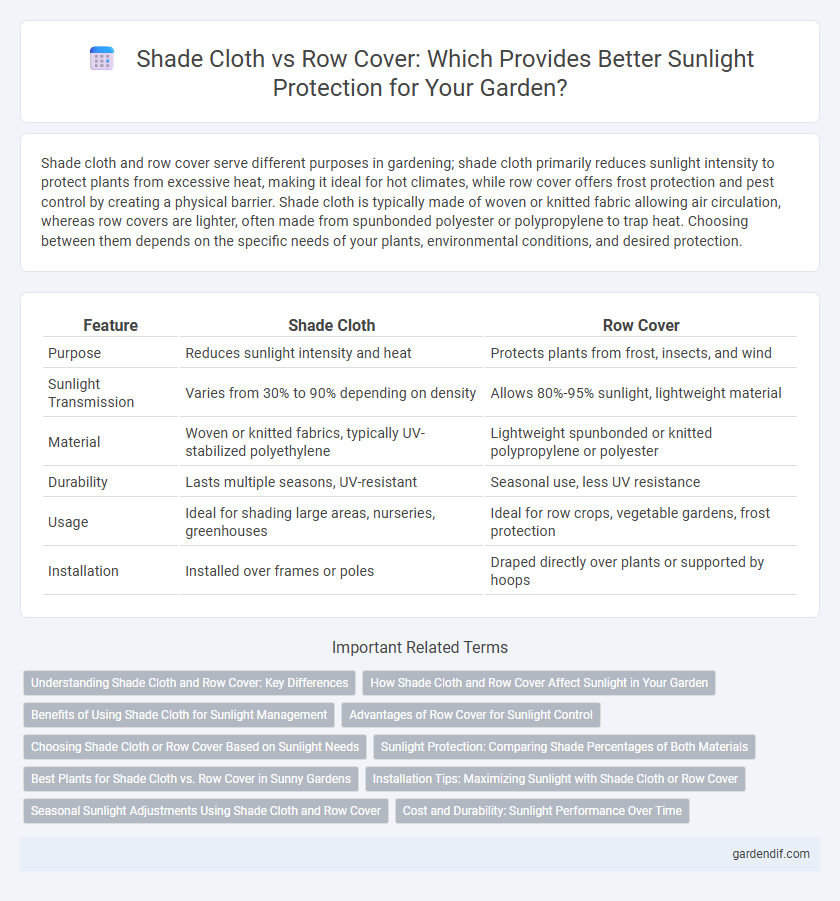
Shade cloth vs row cover Illustration
Shade cloth and row cover serve different purposes in gardening; shade cloth primarily reduces sunlight intensity to protect plants from excessive heat, making it ideal for hot climates, while row cover offers frost protection and pest control by creating a physical barrier. Shade cloth is typically made of woven or knitted fabric allowing air circulation, whereas row covers are lighter, often made from spunbonded polyester or polypropylene to trap heat. Choosing between them depends on the specific needs of your plants, environmental conditions, and desired protection.
Table of Comparison
| Feature | Shade Cloth | Row Cover |
|---|---|---|
| Purpose | Reduces sunlight intensity and heat | Protects plants from frost, insects, and wind |
| Sunlight Transmission | Varies from 30% to 90% depending on density | Allows 80%-95% sunlight, lightweight material |
| Material | Woven or knitted fabrics, typically UV-stabilized polyethylene | Lightweight spunbonded or knitted polypropylene or polyester |
| Durability | Lasts multiple seasons, UV-resistant | Seasonal use, less UV resistance |
| Usage | Ideal for shading large areas, nurseries, greenhouses | Ideal for row crops, vegetable gardens, frost protection |
| Installation | Installed over frames or poles | Draped directly over plants or supported by hoops |
Understanding Shade Cloth and Row Cover: Key Differences
Shade cloth and row cover differ primarily in material composition and function; shade cloth is typically made of woven or knitted fabric designed to reduce sunlight intensity by 30% to 90%, while row cover consists of lightweight, translucent fabric that offers frost protection and pest control. Shade cloth is ideal for creating cooler environments and preventing leaf scorch in hot climates, whereas row cover supports plant growth by retaining heat and moisture. Gardeners select shade cloth for sun-intensive crops and row cover for temperature-sensitive plants requiring protection from cold and insects.
How Shade Cloth and Row Cover Affect Sunlight in Your Garden
Shade cloth reduces sunlight intensity by filtering and diffusing UV rays, helping to protect plants from excessive heat and sunburn while maintaining adequate light for photosynthesis. Row covers provide a lighter barrier, offering partial shade that allows more sunlight penetration and warmth retention, which is ideal for frost protection and early season growth. Selecting between shade cloth and row cover depends on the specific light requirements and temperature needs of your garden plants.
Benefits of Using Shade Cloth for Sunlight Management
Shade cloth effectively reduces solar radiation by blocking up to 90% of sunlight, creating a controlled environment that prevents crop overheating and sunburn. Unlike row covers, shade cloth promotes air circulation while providing UV protection, enhancing plant growth and reducing water evaporation. This targeted sunlight management improves photosynthesis efficiency and increases overall crop yield in high-exposure conditions.
Advantages of Row Cover for Sunlight Control
Row covers provide superior sunlight control by diffusing intense sunlight, reducing heat stress on plants while allowing optimal light penetration for photosynthesis. Their lightweight, breathable fabric protects crops from UV radiation and temperature fluctuations, promoting healthier growth. Unlike shade cloths, row covers can be easily secured around individual plants, offering targeted protection and conserving moisture effectively.
Choosing Shade Cloth or Row Cover Based on Sunlight Needs
Shade cloth and row covers serve different sunlight management purposes in gardening; shade cloth reduces light intensity to protect plants from excessive sun and heat, while row covers allow more light penetration and provide frost protection. When choosing between the two, consider the specific sunlight tolerance of your crops, with shade cloth ideal for heat-sensitive plants requiring 30-70% sunlight reduction, and row covers suited for early-season crops needing frost protection with minimal light obstruction. Factors such as UV blockage percentage, fabric density, and ventilation should guide selection to optimize plant growth and yield under varying sunlight conditions.
Sunlight Protection: Comparing Shade Percentages of Both Materials
Shade cloth typically provides sun protection ranging from 30% to 90% shade, depending on the density and material composition, making it ideal for reducing sunlight intensity in gardens and greenhouses. Row covers generally offer lower shade percentages, often between 10% and 50%, designed more for frost protection and insect control than extensive sun blocking. Sunlight protection efficiency varies by product, with shade cloth preferred for high-shade needs and row covers suited for moderate shade with added environmental benefits.
Best Plants for Shade Cloth vs. Row Cover in Sunny Gardens
Shade cloth is ideal for heat-sensitive plants like lettuce, spinach, and tomatoes, as it reduces sunlight intensity and prevents leaf scorch in sunny gardens. Row covers protect against pests and light frost while allowing more sunlight through, making them suitable for crops such as carrots, broccoli, and early-season greens. Choosing the appropriate cover depends on plant sensitivity to heat and pest exposure in full-sun environments.
Installation Tips: Maximizing Sunlight with Shade Cloth or Row Cover
Shade cloth installation requires securing edges tightly using stakes or weights to prevent gaps that reduce shading efficiency, while positioning at an optimal height ensures consistent sunlight diffusion without overheating plants. Row covers should be anchored firmly with clippers or soil mounds to maintain close contact with crops, maximizing warmth and light penetration while protecting against pests and frost. Both materials benefit from tension adjustments and morning sun orientation to enhance photosynthesis and crop yield.
Seasonal Sunlight Adjustments Using Shade Cloth and Row Cover
Shade cloth regulates sunlight intensity by reducing solar radiation, making it ideal for hot seasons to prevent plant overheating and sunburn. Row covers provide lighter protection by filtering sunlight while retaining warmth, suitable for early spring or late fall to extend growing seasons and protect against light frost. Seasonal sunlight adjustments benefit from combining shade cloth's cooling effects in summer with row cover's thermal insulation during cooler periods.
Cost and Durability: Sunlight Performance Over Time
Shade cloth offers greater durability and long-term sunlight management compared to row covers, typically lasting several years with UV-resistant materials while maintaining consistent light filtration. Row covers, generally more affordable upfront, provide temporary protection but degrade faster under prolonged sunlight exposure, often requiring seasonal replacement. The cost-effectiveness of shade cloth increases over time due to its resilience and stable performance in regulating sunlight for plants.
Shade cloth vs row cover Infographic

 gardendif.com
gardendif.com